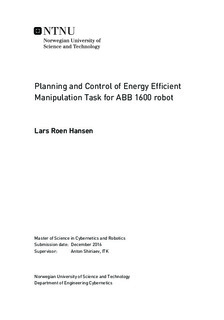Planning and Control of Energy Efficient Manipulation Task for ABB 1600 robot
Master thesis
Permanent lenke
http://hdl.handle.net/11250/2441145Utgivelsesdato
2016Metadata
Vis full innførselSamlinger
Sammendrag
Due to the ever increasing number of industrial robots in the world, working day and night producing and manufacturing, a need has arisen to make sure that these robots work energy efficient. This is both to make robots cost effective for businesses and environmentally friendly.
During the course of this thesis a method for planning an energy efficient velocity profile for an ABB IRB 1600 robot has been developed. This method does not only look at the assignment of velocity and acceleration along a path, but also the gain of energy efficiency that optimizing the position and orientation of a manipulation task have.
The result of this method shows that the optimal position and orientation gives a minimization of the movement of the second joint, and that at this optimal position the gain in energy efficiency of the optimal orientation is 161.1% from the horizontal plane. The optimal trajectory also have a 16.3% smaller energy consumption than a trajectory made by ABBs own motion planner in the optimal plane. Thus, the work done in this thesis optimize energy in two ways.
Experiments were also performed to find the maximum and minimum torque for the first three joints of the robot. This was supposed to be used when constraining acceleration and jerk. These constraints were however excluded from the optimization scheme as the energy efficient trajectories obtained were nowhere close to the torque bounds. These experimental results are however greatly of interest when looking at time-optimal trajectories, and can be reused for this purpose.
